Ecommerce trends in 2024 are transforming how online retailers attract shoppers, create loyal customers, and personalize brand experiences. In both B2C and B2B spaces.
If you're still using last year's marketing channels, technology, and playbook, your ecommerce business may miss key opportunities to grow revenue and your customer base.
So, what are the current trends in ecommerce?
In this article, we'll explore 17 trends currently shaping online shopping—including new marketing channels, advanced ecommerce technologies, and personalization strategies. To help you keep up and shape your ebusiness’s marketing strategy accordingly.
1. Increased Competition for Advertising Space
Ecommerce business owners now have more options to promote their products across Google's advertising networks.
Both Shopping and Performance Max campaigns use Google Merchant Center feeds to display ecommerce product listing ads (PLAs) at the top of search results.
Like this:
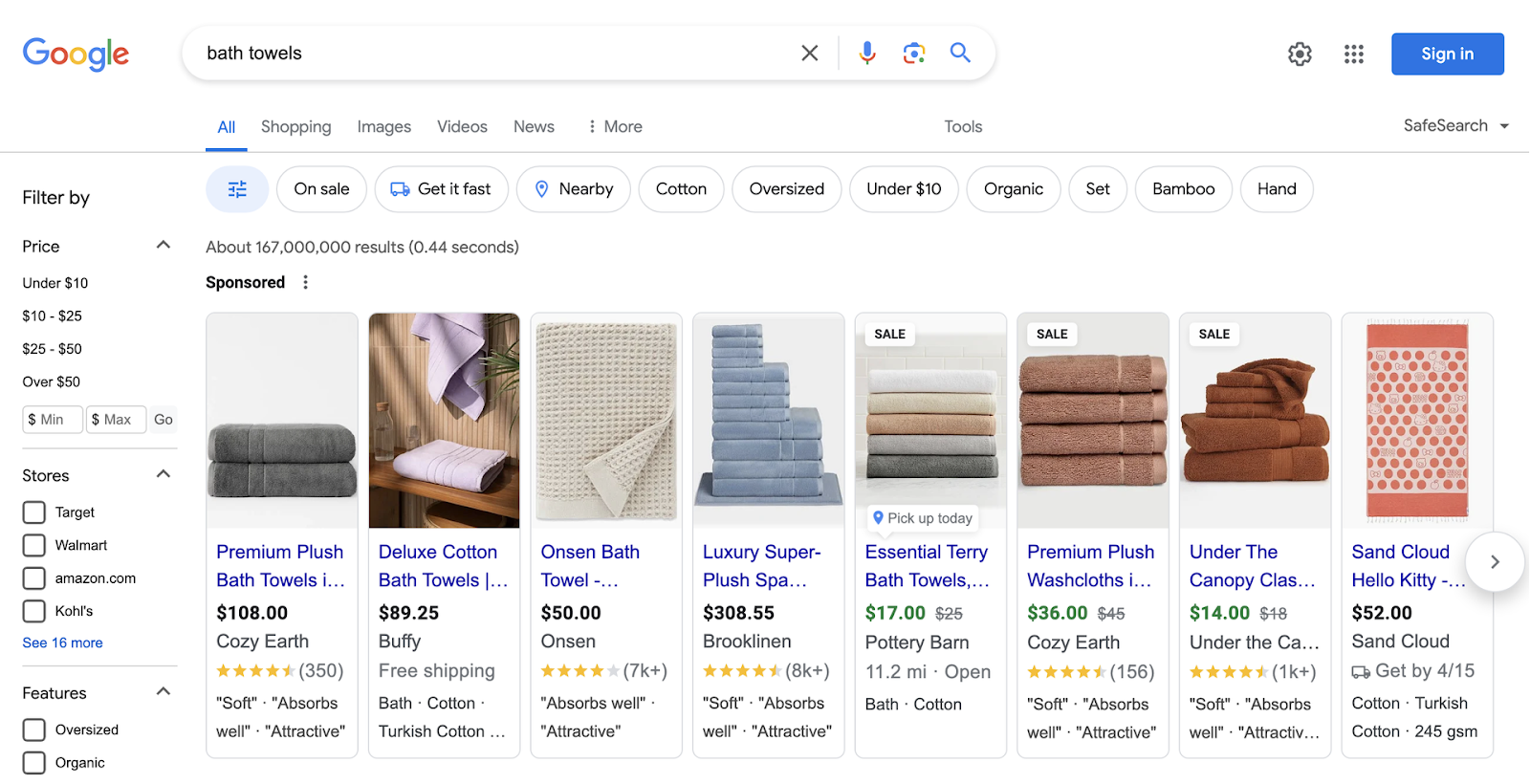
Google Ads introduced generative AI tools for Performance Max campaigns in late 2023. The tools allow advertisers to create headlines, descriptions, and images with AI.
Now that these campaigns are even easier to launch, they will likely lead to more ads—and higher competition as a result.
To create successful campaigns, you need more insight into other advertisers' strategies. Use Semrush's PLA Research to find your competitors' PLAs and see which ads show for specific keywords.
Open the “Advertising” drop-down menu and select “PLA Research.” Enter a competitor's domain in the tool and click "Search."

You'll see a complete list of the ecommerce domain's PLAs. The “PLA Positions” chart shows competitor keywords, product titles, each ad's average position, keyword search volume, and more.
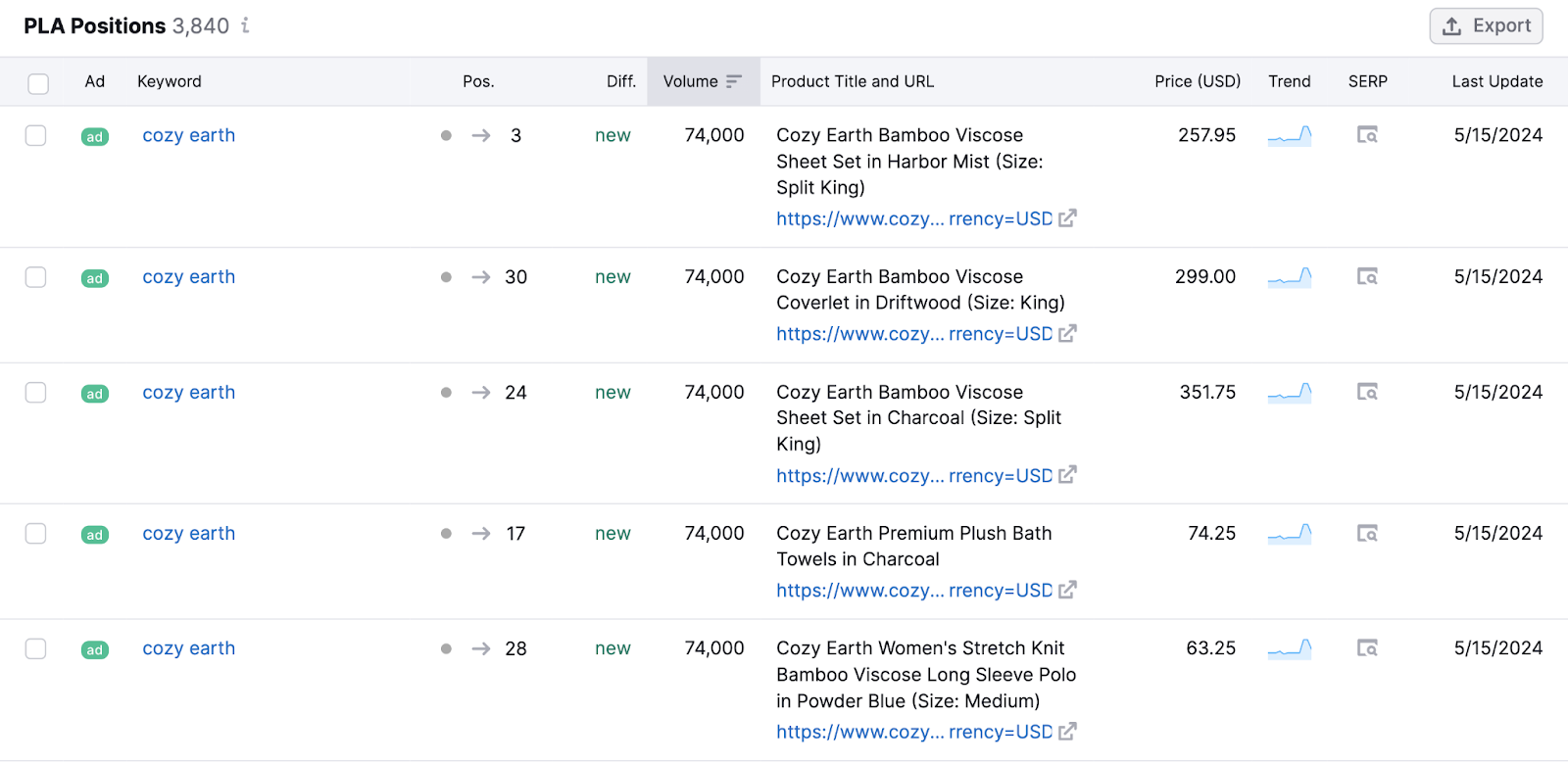
Find top-performing PLAs for keywords your business wants to target. Then optimize your ads using your competitors' product titles as a guide. Continue checking PLA Research to monitor how your ads fare against the competition.
2. Personalized Shopping Experiences
Generic shopping experiences are no longer the norm for online channels. Research by McKinsey shows that 71% of digital consumers expect a personalized shopping experience.
Customization can prompt customers to resume browsing, repurchase items, and explore trending products.
Further, companies that master this kind of ecommerce customer experience reportedly generate 40% more revenue from personalization practices than other businesses.
To provide a personalized digital experience on your ecommerce site, you need data like:
- Consumer preferences, including browsing and shopping history
- What products customers are most likely to purchase together
- How frequently customers tend to repurchase specific items
For example, Amazon uses data analytics and AI to customize the shopping experience.
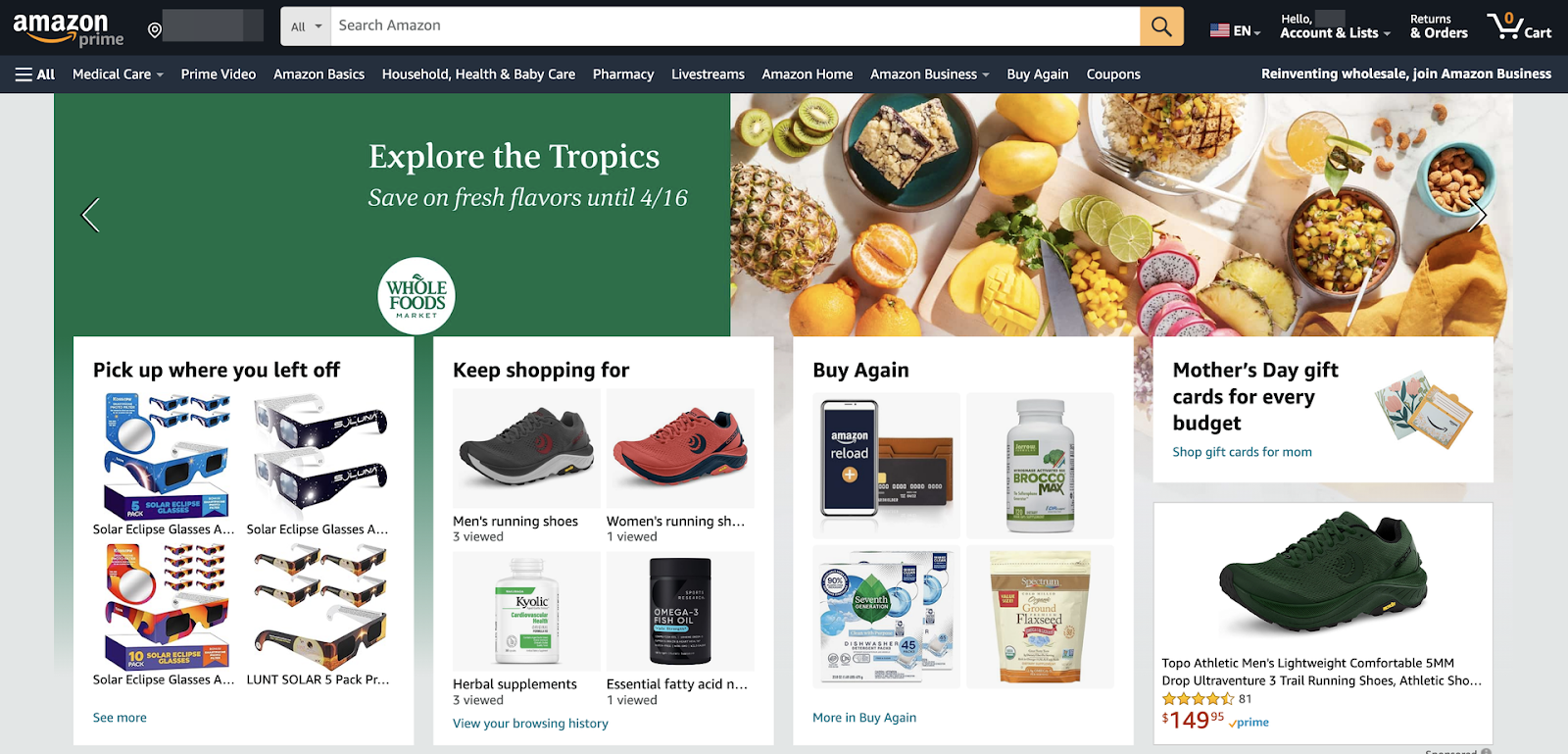
The online marketplace encourages buyers to continue browsing previously viewed products—and to repurchase items.
3. Upselling and Cross-Selling with AI
Many of the best ecommerce businesses use AI to upsell and cross-sell items during checkout.
Such AI-powered tools help retailers analyze customer shopping habits. They can identify products people frequently buy together and items they purchase after considering others.
Ecommerce retailers often boost average order value (AOV) by using AI to recommend relevant add-ons and alternatives. Upselling generally increases revenue by 10% to 30%, according to BDOW! (formerlySumo).
Here's an example:
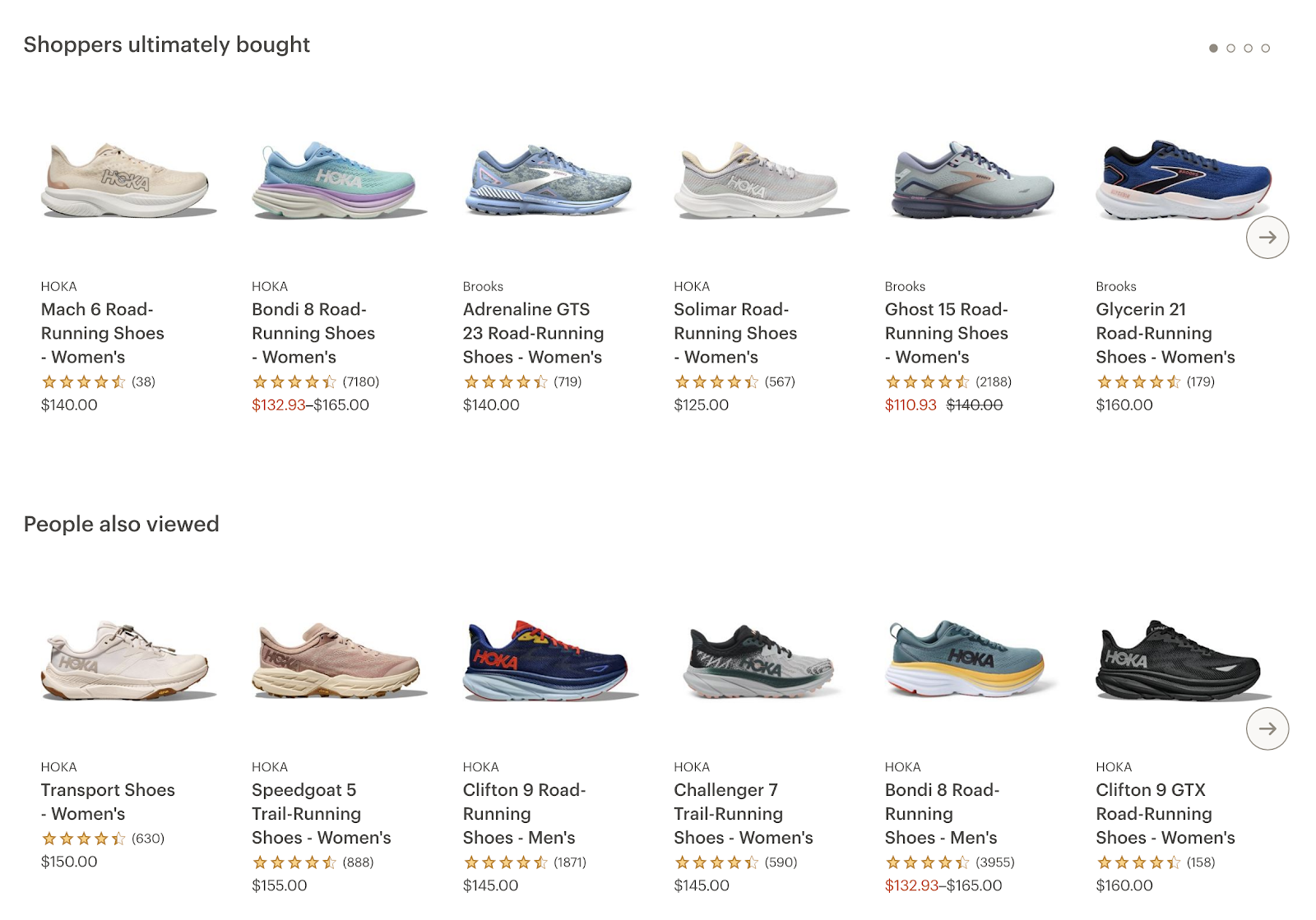
Outdoor gear brand REI recommends similar products that other online shoppers viewed or bought. Many carry a higher price than the original item.
After customers add items to their cart, REI cross-sells accessories, related gear, and complementary clothing. This way:
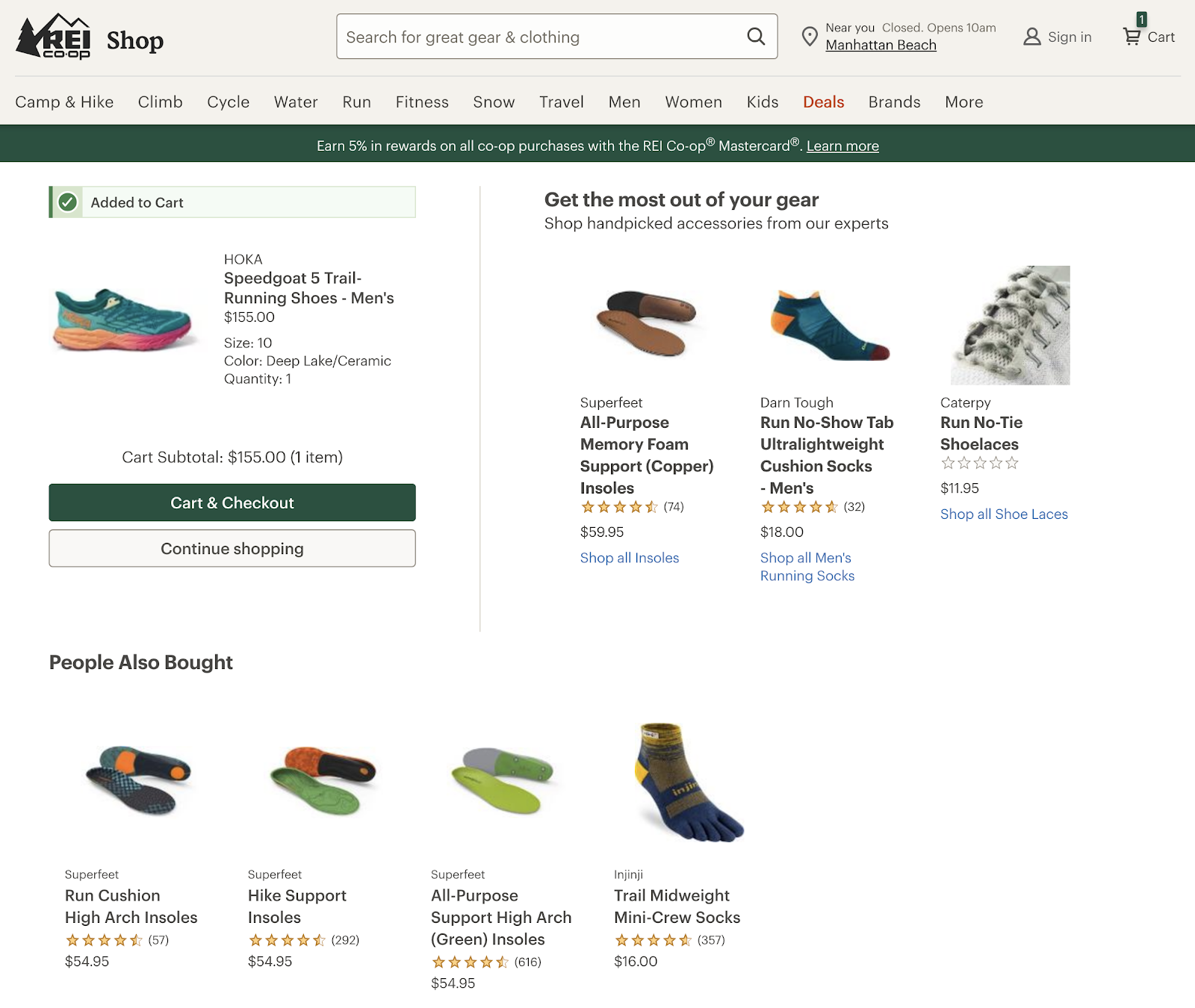
4. AI-Powered Chatbots
AI-powered chatbots are increasingly replacing traditional customer engagement and support channels like phone and email.
Gartner predicts that about a quarter of organizations will use chatbots as their primary customer service channel by 2027.
The most sophisticated chatbots act more like ecommerce virtual assistants, handling complex customer service interactions and providing 24/7 personalized support. Some respond to consumer behavior by offering shopping assistance and styling advice.
For instance, fashion brand Uniqlo’s IQ Virtual Shopping Assistant performs searches for shoppers, provides product recommendations, and answers questions about inventory.
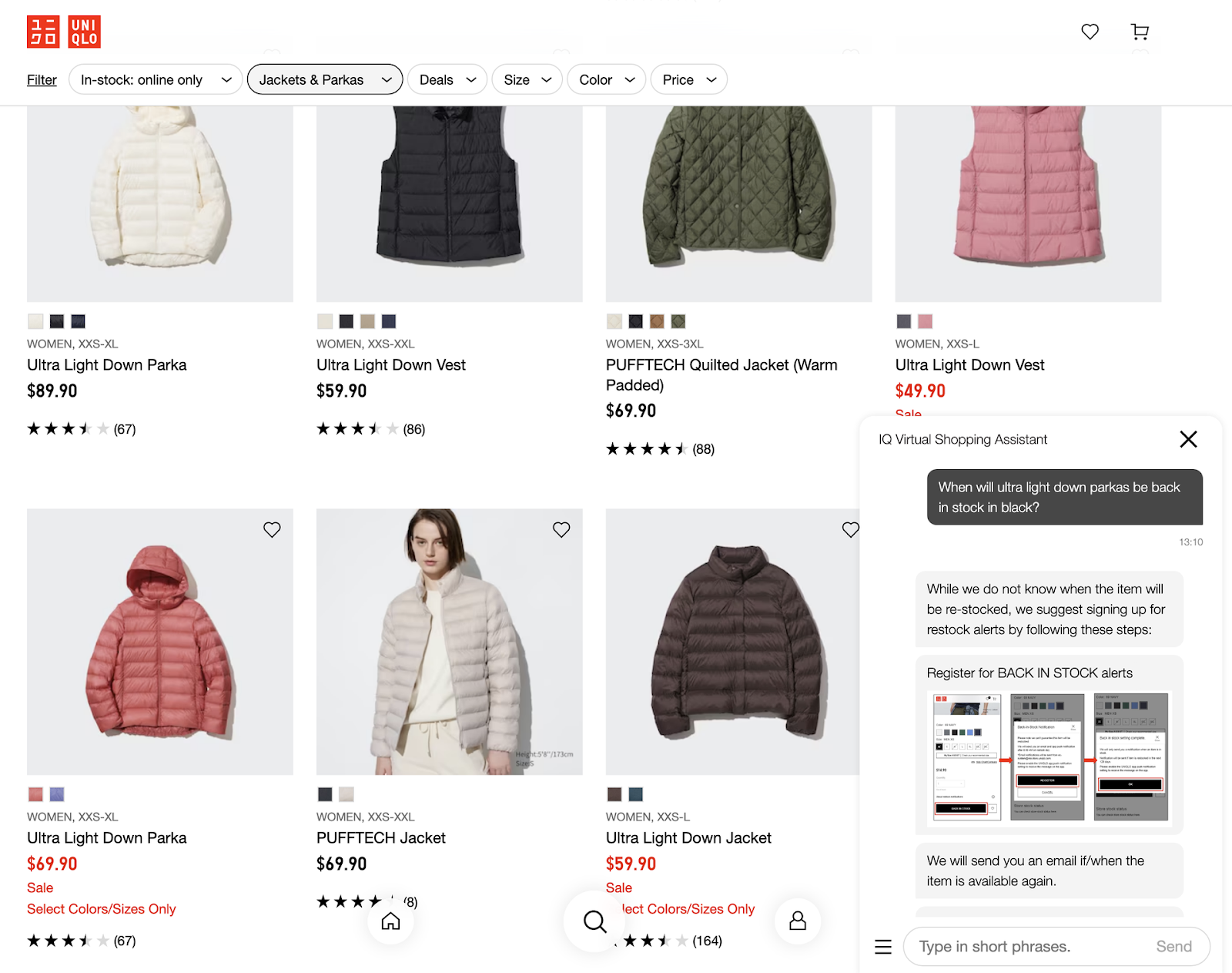
When necessary, Uniqlo also directs customers to relevant resources for more info.
5. Shopping Directly on Social Media Platforms
Consumers don't have to visit ecommerce websites and online marketplaces to shop. In 2024, many ecommerce retailers have begun selling products on social media platforms—for social commerce purposes.
An October 2023 eMarketer study shows that 19% of respondents purchased on Facebook in one month. And 14% bought on Instagram while 10% shopped on YouTube. Although TikTok Shop only launched in September 2023, 10% of respondents had already purchased on the platform by that time.
In the example below, customers can tap the "Shop" button on Spindrift Sparkling Water’s Instagram profile:
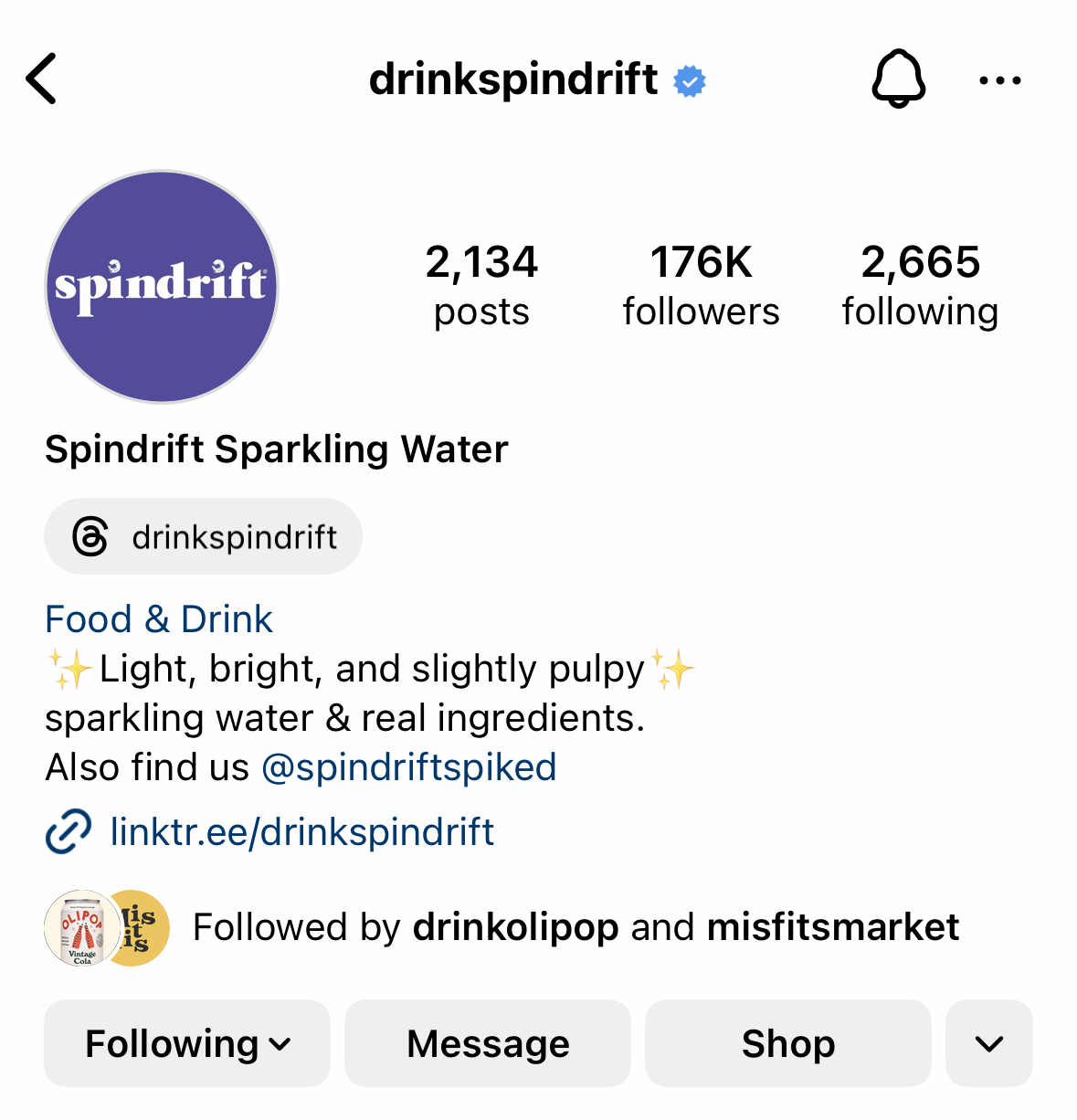
Brands can also tag items in Instagram posts, reels, and stories. Like in this Spindrift Instagram post:
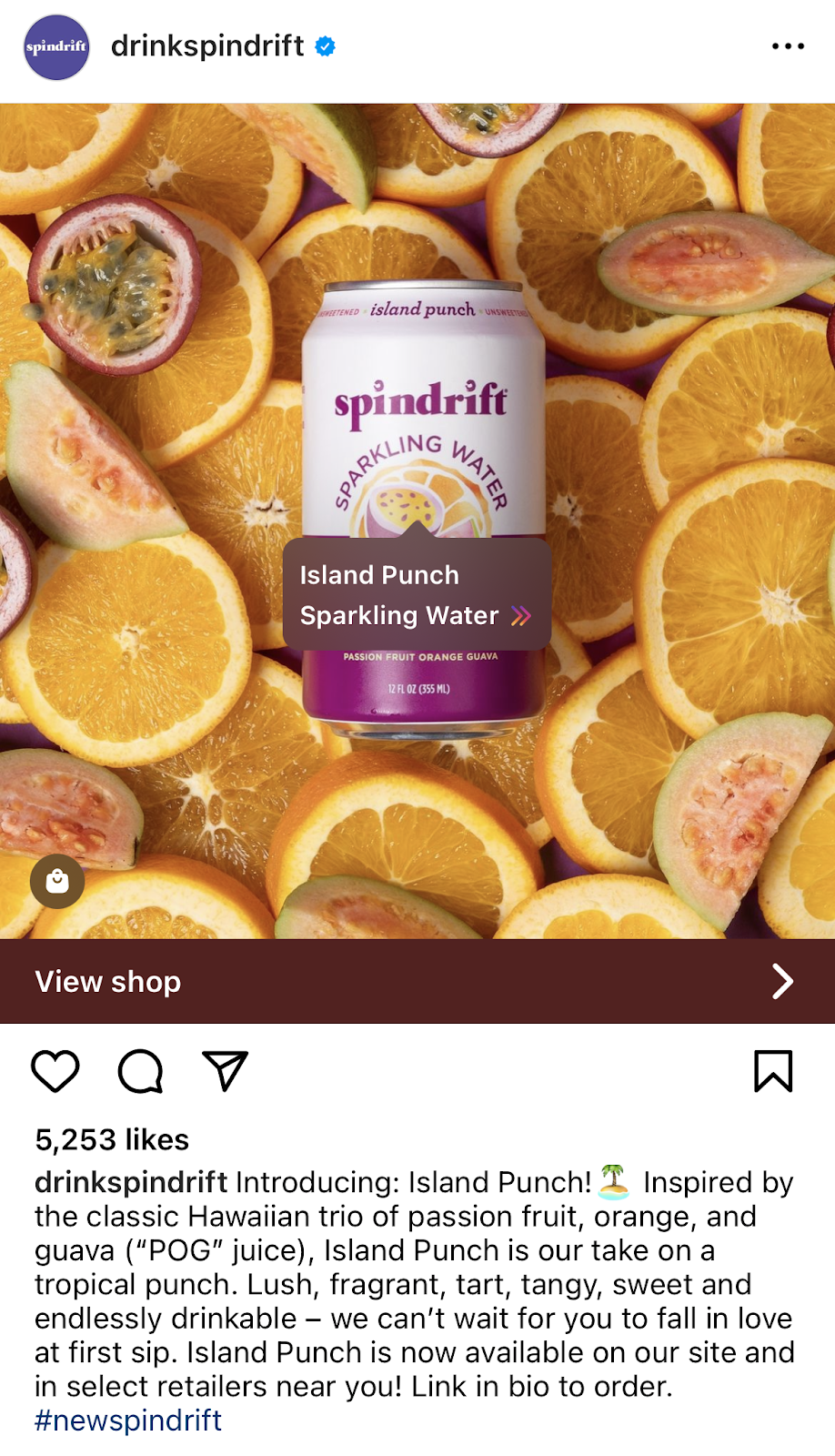
Meaning customers can browse and buy items without leaving the social media channel.
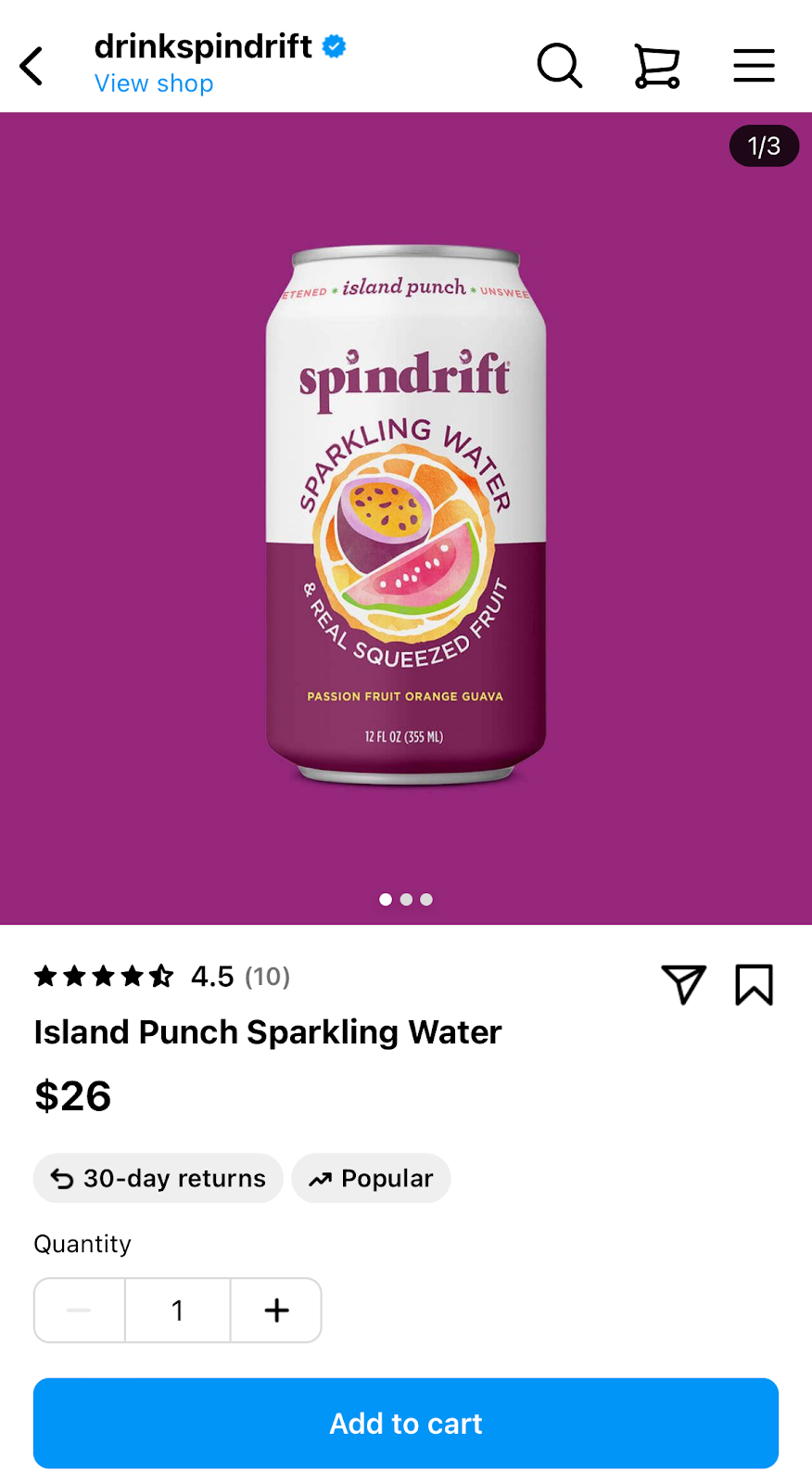
6. Seamless Shopping Experiences Across Platforms
Customers often interact with a brand multiple times across channels before purchasing.
Not all customer touchpoints involve a website visit. People may use your app, browse your marketplace listing, or visit your shop on social media.
Aim to create a consistent shopping experience on all platforms and devices. You'll build customer trust and reduce frustration, making it easier to browse and buy.
For instance, US retailer Target offers a seamless experience from its website to its mobile app—allowing shoppers to map out their own customer journey.
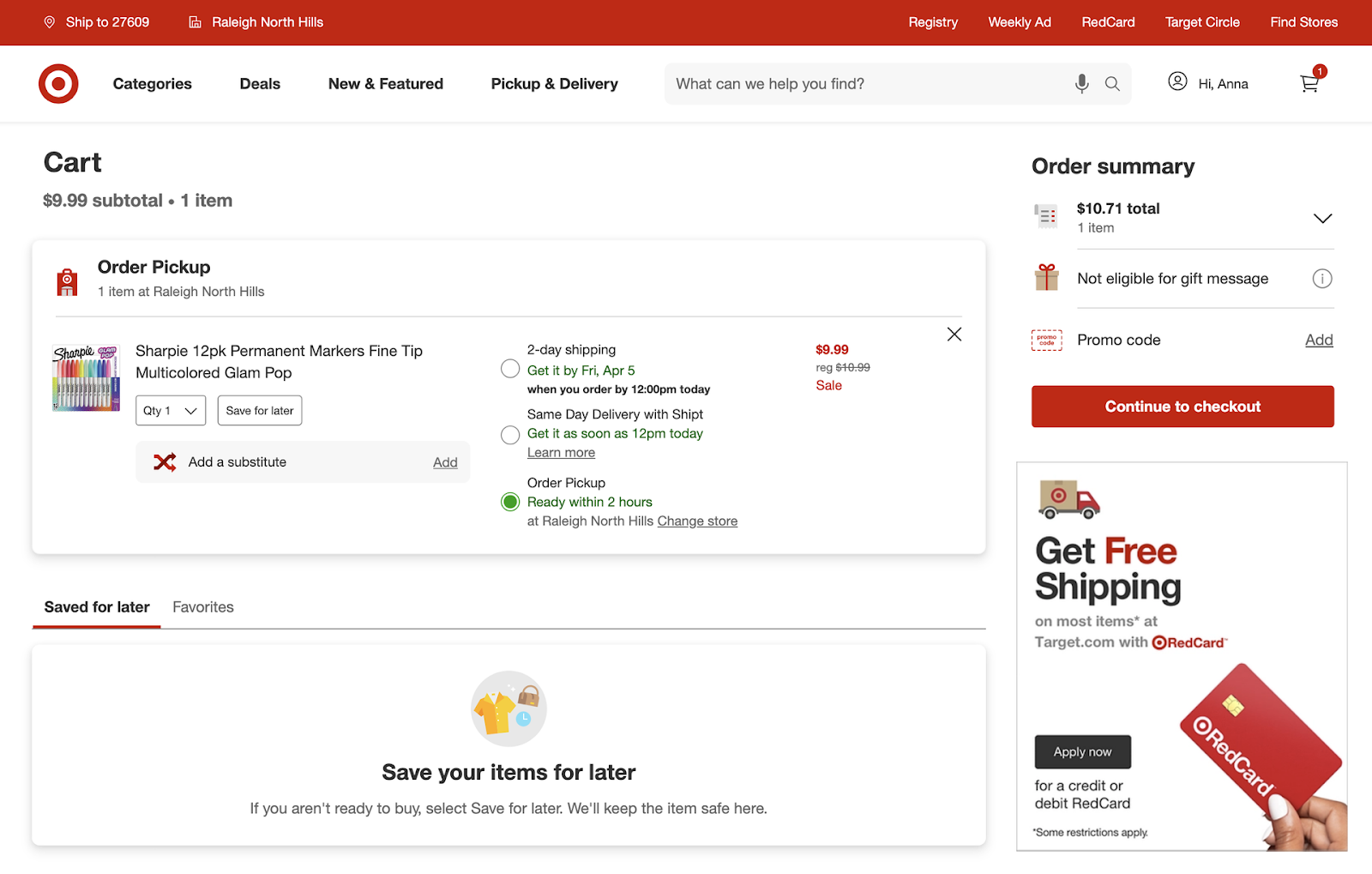
Target's ecommerce navigation and checkout flow are very similar across devices. Creating a cohesive experience for shoppers.
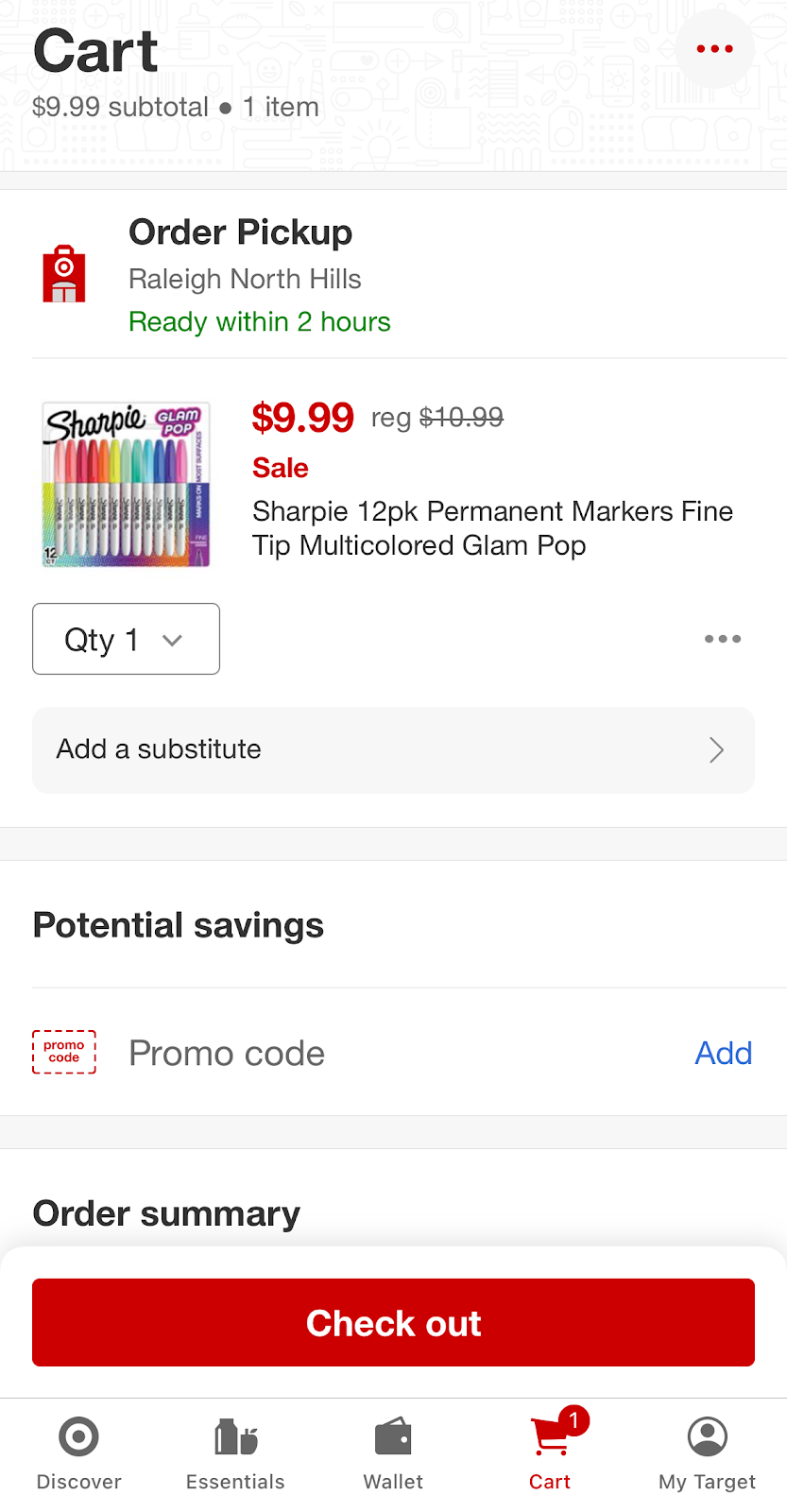
7. Emphasis on High-Quality Creative
Marketing creative—the visual aspect of your content—has become increasingly useful for engaging customers, driving conversions, and generating online retail sales.
A Marketing Week study shows that 80.5% of marketers rate creative among the most influential factors when it comes to campaign success.
So, consider creative assets as essential ecommerce marketing tools for your brand. And invest in high-quality images, videos, plus interactive content across channels.
Take accessories company Mokuyobi. The brand's Instagram grid features bright, colorful images—like this post:
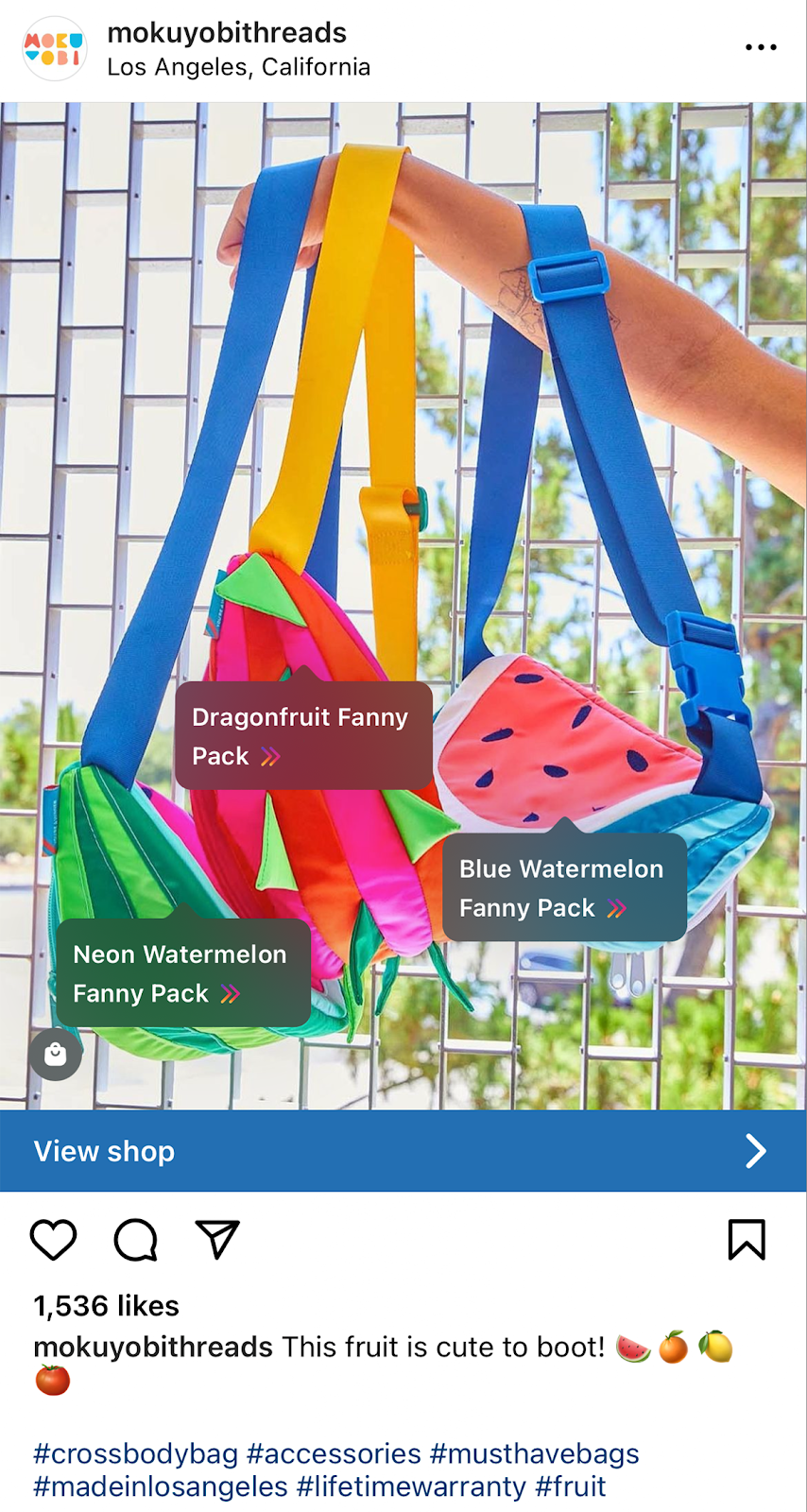
Mokuyobi adds product tags to images (above) and short-form reels (below) to make the content more shoppable.
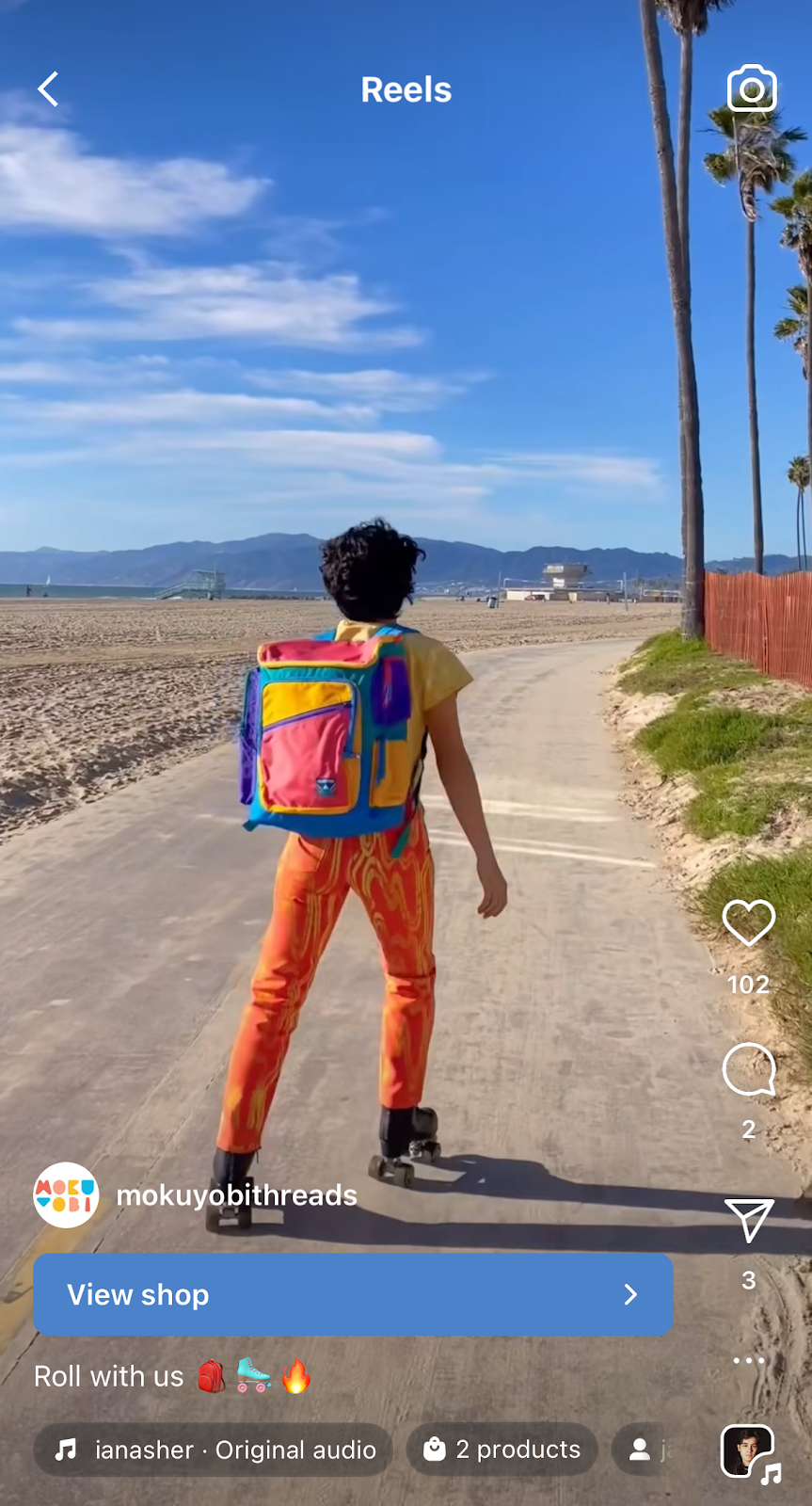
8. Augmented Reality (AR) Shopping Experiences
AR shopping allows consumers to experience products virtually instead of in person.
Foresight Factory found that three in 10 consumers prefer trying on clothing with AR rather than in-store. And predicts sales growth as a direct result of an AR shopping surge by 2025.
This emerging trend in ecommerce is ideal for:
- Clothing
- Accessories
- Makeup
- Furniture
- Home goods
Let’s take EyeBuyDirect. The prescription eyewear brand offers an AR tool that lets shoppers try on glasses by uploading a selfie or using the live camera feed.
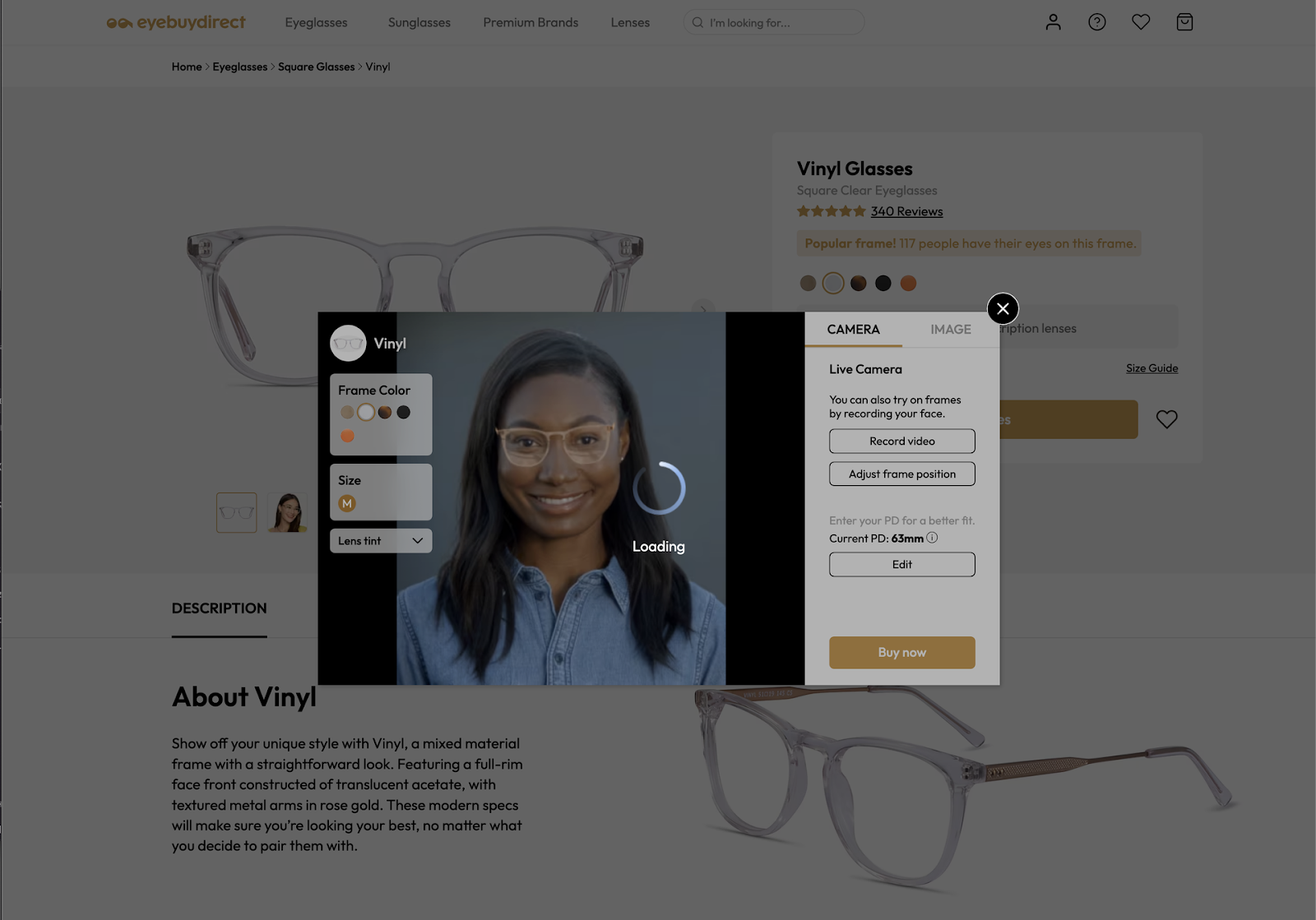
9. Voice Search Optimization
Data from Statista shows that consumers in 2021 used voice assistants to make $4.6 billion in ecommerce purchases. The figure grew exponentially to $19.4 billion in 2023.
Optimize for voice shopping to leverage this ecommerce growth trend. Make your products visible to the most popular voice assistants (Alexa and Google Assistant) and smart speakers (Amazon Echo and Google Home).
Here’s how:
- Include Amazon keywords in product descriptions to make your ecommerce items easier to find on Amazon. As the products become more popular, Alexa will be more likely to suggest them for item requests.
- Use ecommerce SEO best practices like incorporating keyword research and optimizing for on-page SEO elements. These steps will make your products more visible across Google Search and Google Assistant.
In addition, consider adding voice search to your mobile app. For instance, the app from global beauty retailer Sephora lets shoppers submit search queries by voice or barcode.
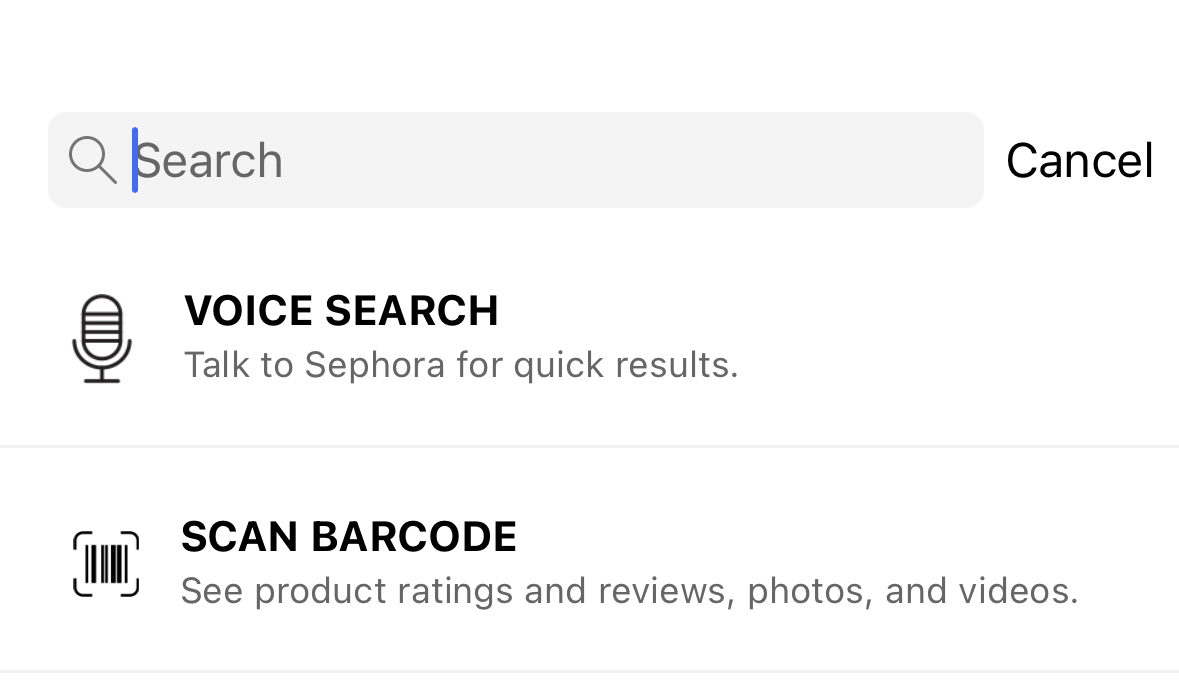
10. Enhanced Focus on Mobile Shopping
The Pew Research Center reports that 76% of U.S. adults use smartphones for online purchases. Mobile phone shopping is highest among adults under 50 (91%).
Stay on top of this B2C ecommerce trend by optimizing your website for smartphones. Apply mobile SEO best practices including:
- Responsive design, which automatically adjusts your display correctly on mobile or desktop devices
- Voice search optimization, which makes it easy for customers to find items using voice search-friendly keywords
- Title tags (between 50 and 60 characters) and meta descriptions (below 120 characters) that display fully in mobile search results
Consider developing a dedicated mobile app to give shoppers more options.
For example, athletic apparel brand Lululemon has a mobile app that lets users customize and purchase items for delivery or in-store pickup.
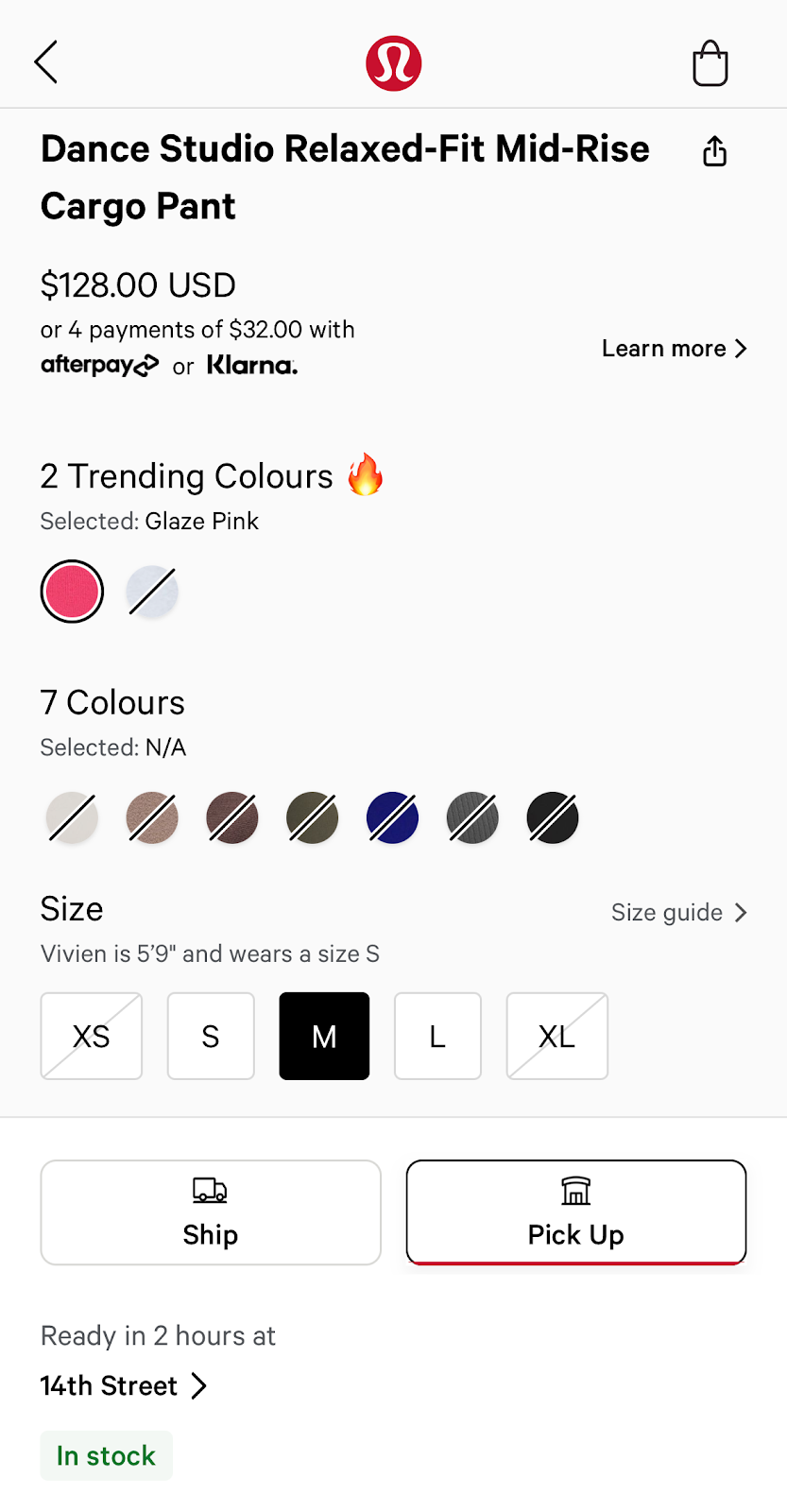
11. Mobile Wallets and Diverse Payment Methods
Accepting credit and debit cards is the expected bare minimum for mobile commerce in 2024. Online businesses now offer a wider range of payment methods to meet consumer demand for convenience and security.
Let’s take online retailer Overstock. Customers can choose from preferred methods including mobile wallets like Google Pay and Shop Pay. Or payment services like Venmo and PayPal.
Overstock also supports Klarna, a service that allows customers to make flexible payments over time.
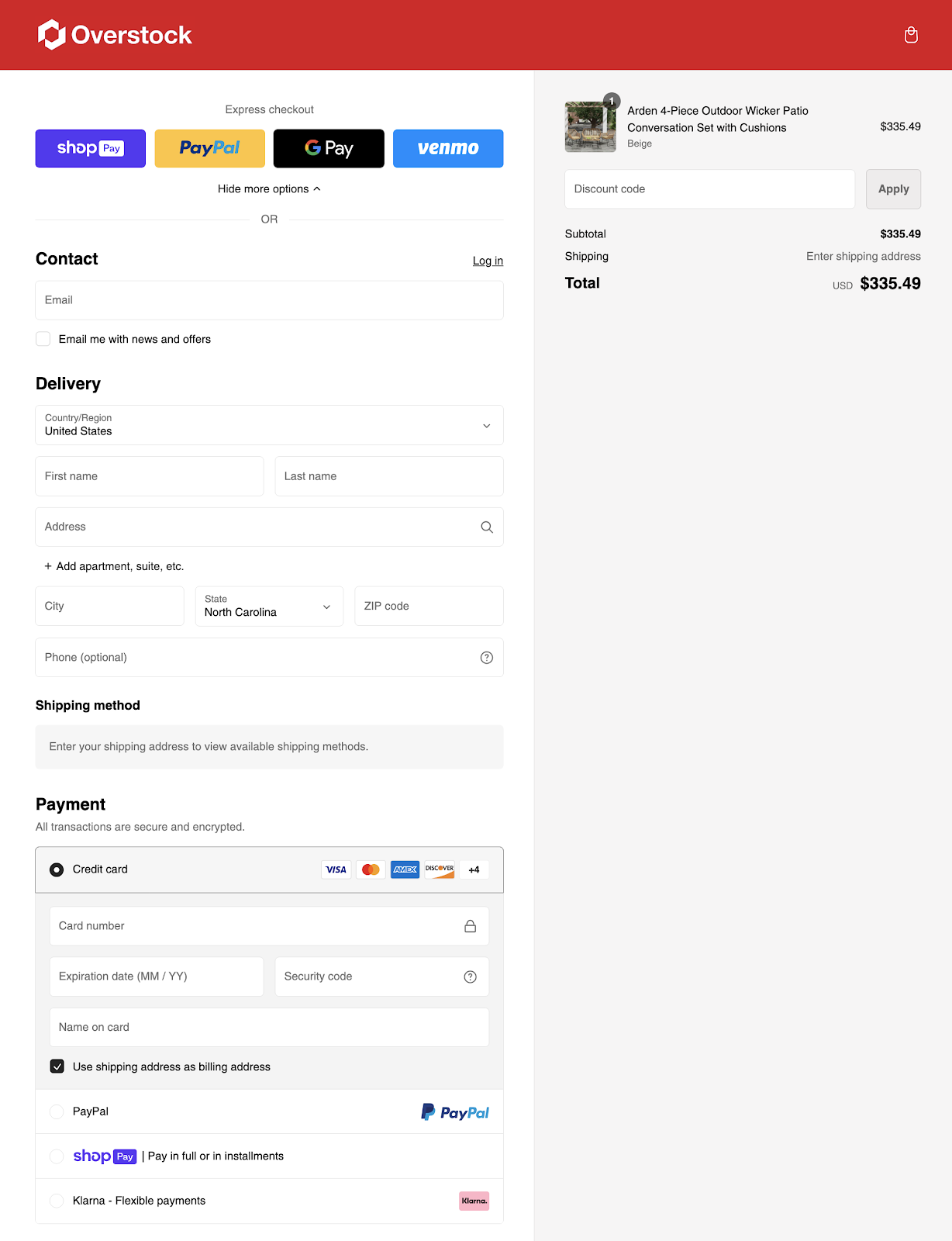
Many ecommerce businesses also accept cryptocurrency. For example, Shopify merchants can allow customers to choose their preferred crypto payment method—like BitPay and Crypto.com.
12. Subscription Services for Consumer Loyalty
Ecommerce subscription models turn one-time purchases into recurring sales. They increase revenue and customer lifetime value (CLV) while cultivating loyalty and ongoing convenience.
The subscription box industry continues to expand and influence shopping habits. Market research company IMARC projects a 14% growth rate between 2024 and 2032.
In the example below, Bouqs customers can buy any boxed flower bouquet as a one-time purchase. Or turn it into a subscription with monthly deliveries.
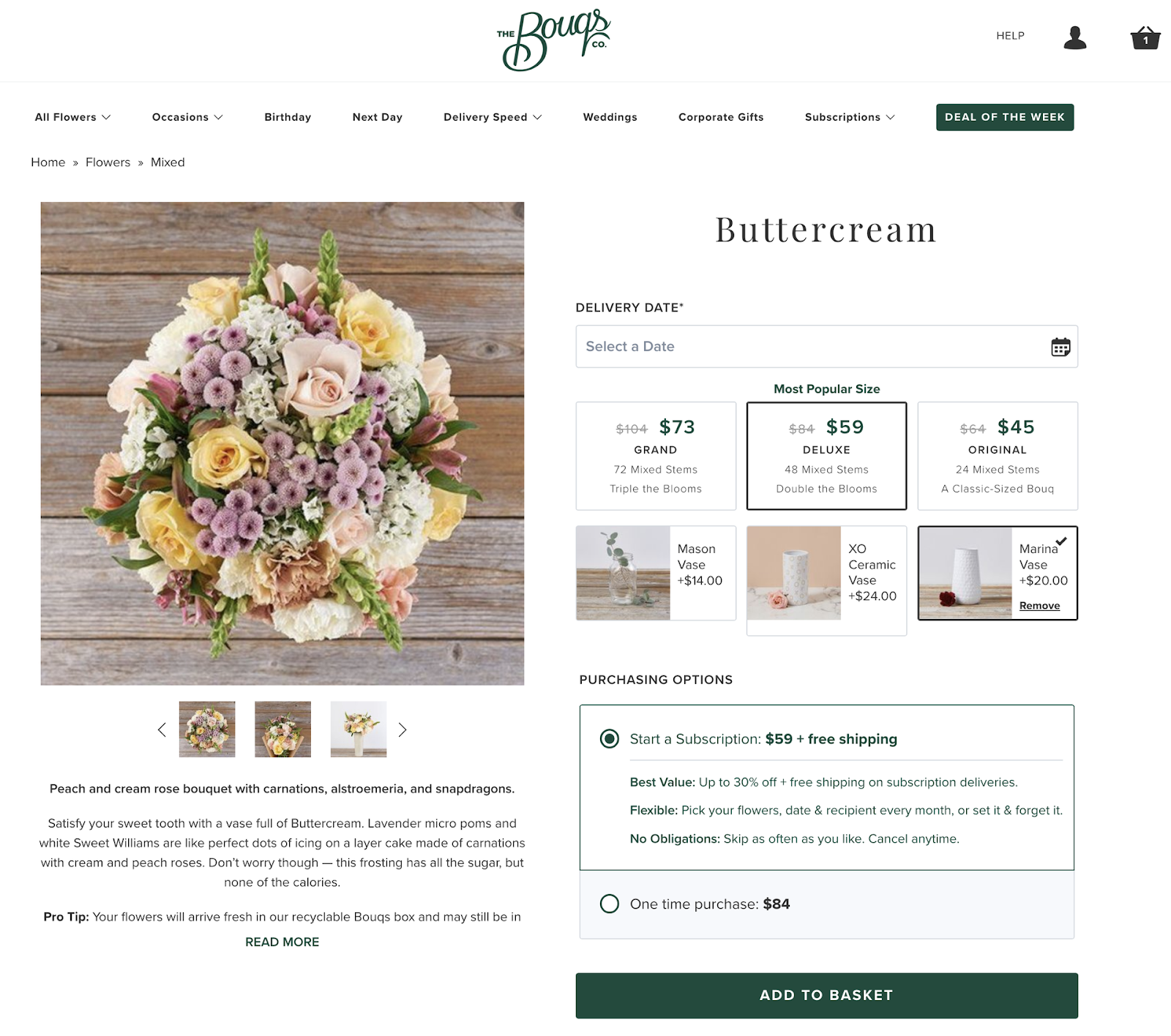
Subscriptions to the floral brand include discounted pricing—to incentivize the initial purchase while enhancing CLV.
13. Faster Delivery and Pickup Options
Online marketplace tools platform Jungle Scout found that 41% of consumers in 2021 expected to receive items bought online within two to three days.
Two to three days is still an acceptable delivery window as of 2023. But many shoppers want to receive their items much faster.
An OnTrac report shows that next-day delivery leads 74% of consumers to purchase. And same-day delivery drives 67% to buy.
Aim to offer next-day or same-day delivery to meet customer expectations. Consider adding an in-store pickup option if your business also has a brick-and-mortar facility.
For example, gaming retailer GameStop gives you three delivery options. Choose from standard one-to-three-day shipping, same-day delivery to select addresses, or same-day pickup at a physical store.
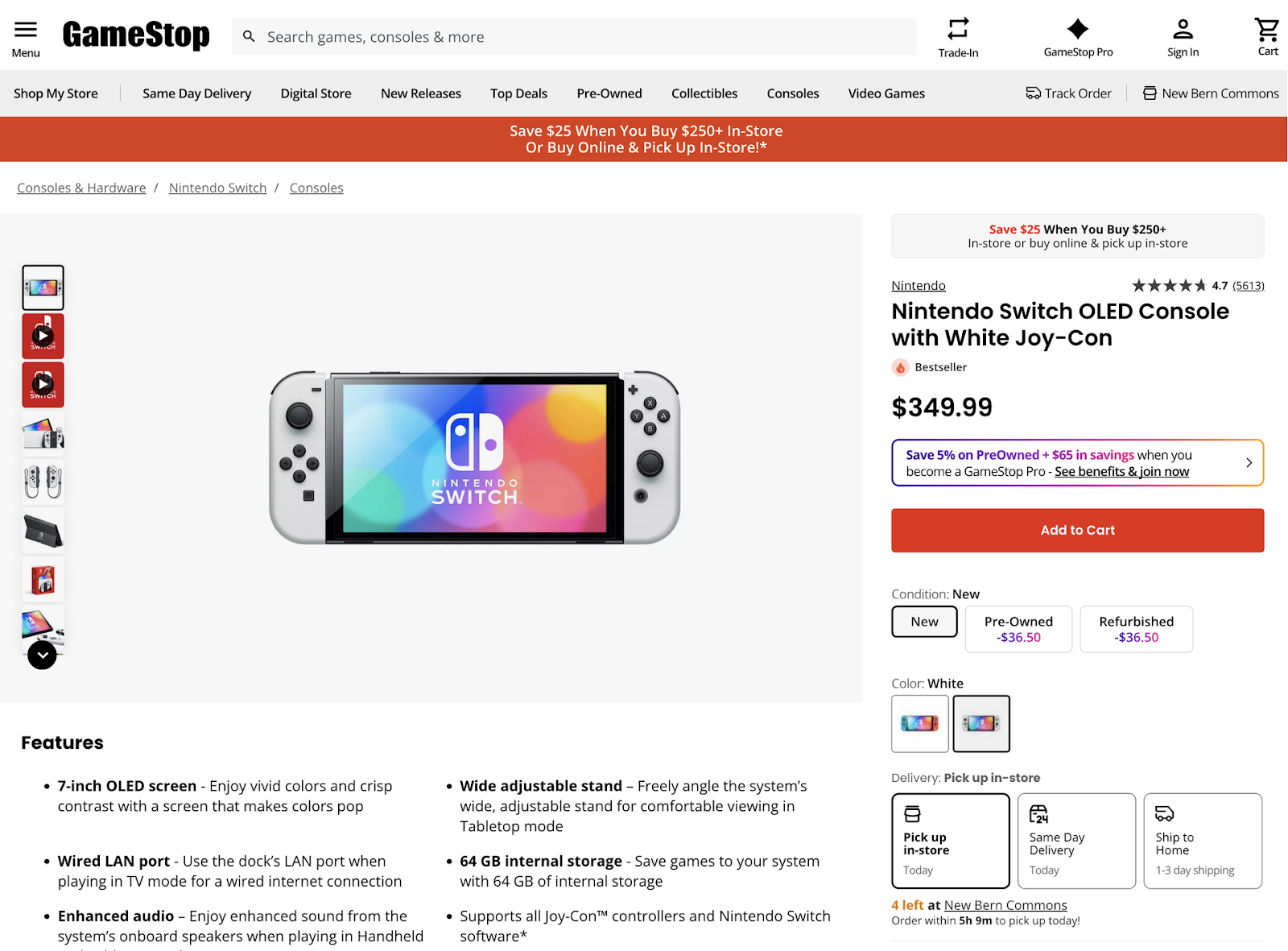
The GameStop website updates dynamically to reflect the number of items available at customers' preferred stores. It also shows how long customers have to place a same-day order for in-store pickup.
14. Eco-Friendly Packaging and Practices
Sustainable ecommerce practices have become essential factors in consumers' purchasing decisions. NielsenIQ reports that 78% consider a sustainable lifestyle important. And 30% are more likely to buy eco-friendly items.
As an ecommerce retailer, you have several options for incorporating sustainable practices:
- Use eco-friendly packaging, including recycled materials
- Offer eco-friendly or carbon-neutral shipping options
- Make sustainability a core element of your company's mission and products
For Pact, sustainability is integral to virtually every element of the business. The ecommerce clothing company relies on organic farming, which Pact reports uses 81% less water and 62% less energy than conventional farming.
The company's products are all carbon neutral. It also uses recyclable paper bags to package products.
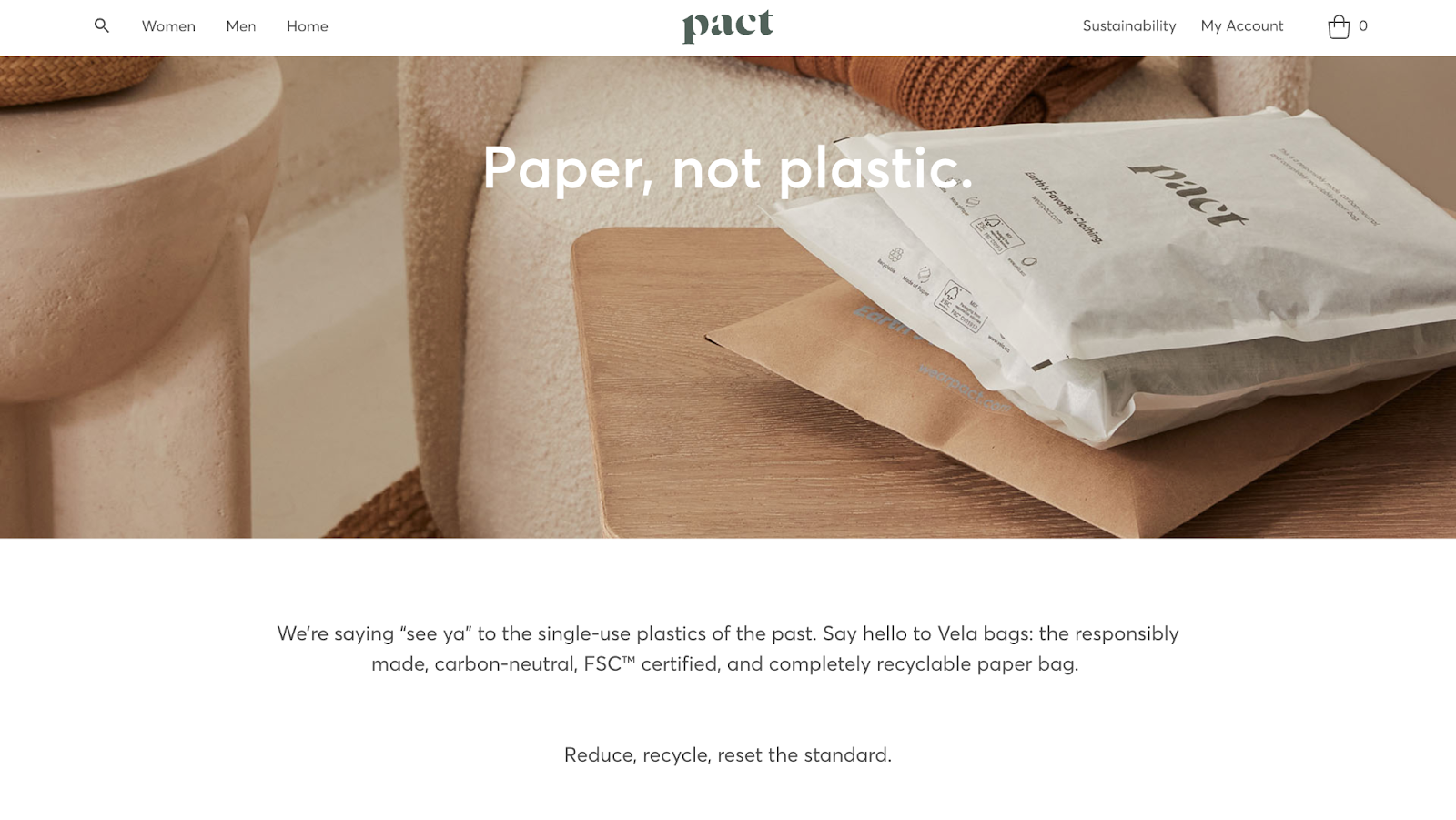
15. Direct-to-Consumer (DTC) Growth
Brands that sell directly to consumers without involving a third-party wholesaler, distributor, or retailer now account for 17% of all U.S. online sales, KPMG reports.
Ecommerce brands benefit from this business model by saving on distribution and wholesale costs. They also have complete control over the entire business process—from manufacturing and marketing to sales and fulfillment.
You need a resilient logistics and fulfillment strategy to succeed with the DTC model. A dedicated employee or team for supply chain management can help you set up a reliable system and address potential challenges.
You'll also need to build a loyal customer base.
Let’s consider apparel store Bombas as an example. The DTC brand's mission is to help people experiencing homelessness, donating an item for every piece of clothing bought.
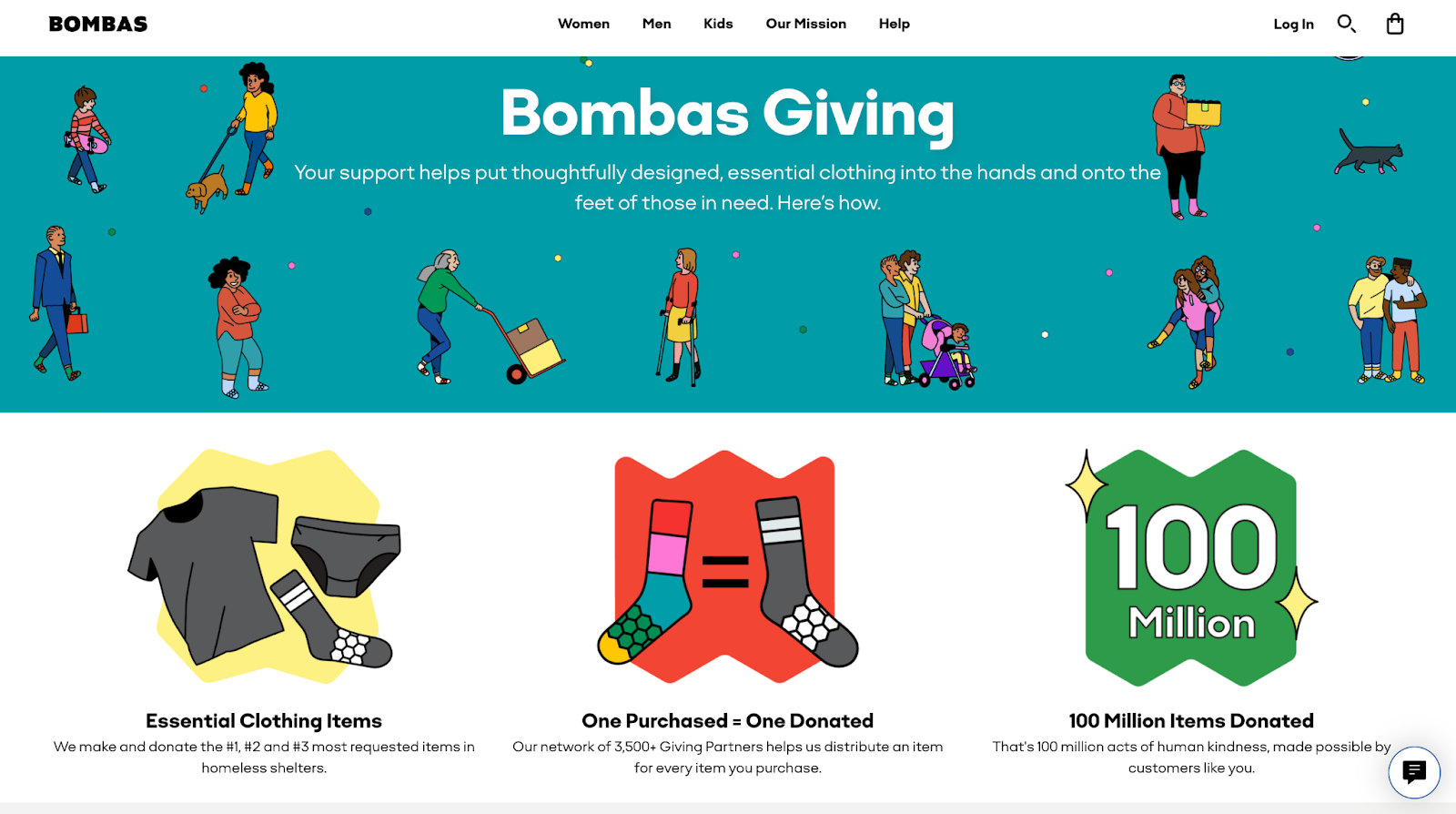
Bombas continues to attract loyal customers who appreciate both its style and mission.
16. Dedicated Options for B2B Ecommerce
Statista projects that B2B ecommerce sales will grow from $2.3 trillion in 2024 to $3.1 trillion in 2027.
Many B2C-leaning companies use separate B2B ecommerce platforms to attract customers and capture a portion of their revenue.
Dedicated B2B ecommerce websites use automation and AI to process orders, recommend repurchases at timed intervals, and invoice appropriate business units.
As a result, B2B customers can order items more efficiently, set up procurement workflows, and get expert advice.
Further reading: 18 Actionable B2B Ecommerce Best Practices
Take Office supply company Staples’ three-tiered Business Advantage program for B2B customers.
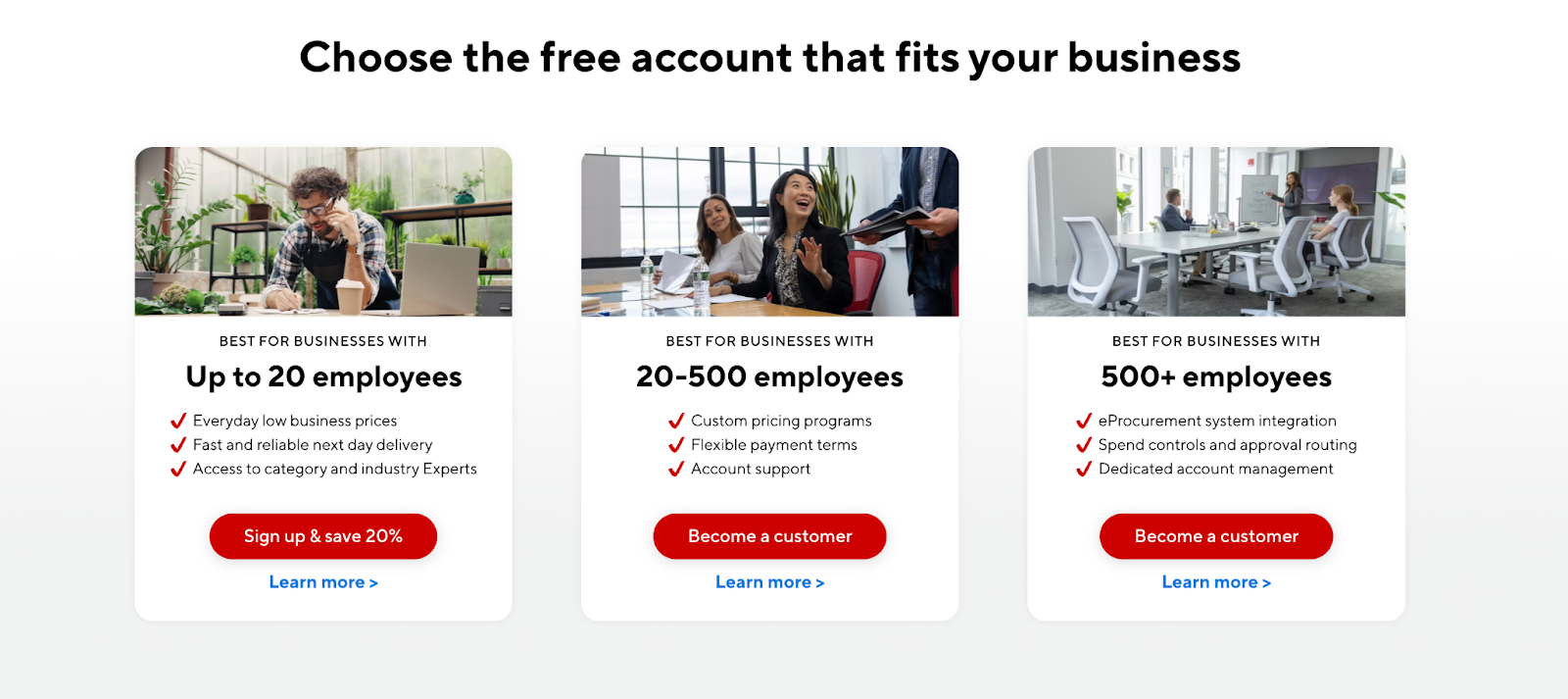
Small businesses with up 20 staff get next-day delivery and access to expert assistance, while those that employ up to 500 people get flexible payment terms.
Larger companies of 500+ workers can avail of eProcurement integrations and approval routing for more efficient purchasing.
17. Prioritizing Privacy and Data Security
Both B2B and B2C ecommerce websites must prioritize data privacy in 2024 and beyond. Cisco reports that 86% of consumers care about data privacy, and 47% have switched companies over inadequate data policies.
For most ecommerce companies, tracking customers via cookies is no longer viable.
Google Chrome intends to phase out third-party cookies by the end of 2024. And Statista indicates that only 25% of users have opted into mobile app tracking on iOS devices.
One of the most effective alternative ways to get to know customers is via zero-party data—information that your consumers willingly and voluntarily share with you.
Let’s consider coffee roasters Counter Culture Coffee. Website visitors can take a quiz to discover their ideal coffee.
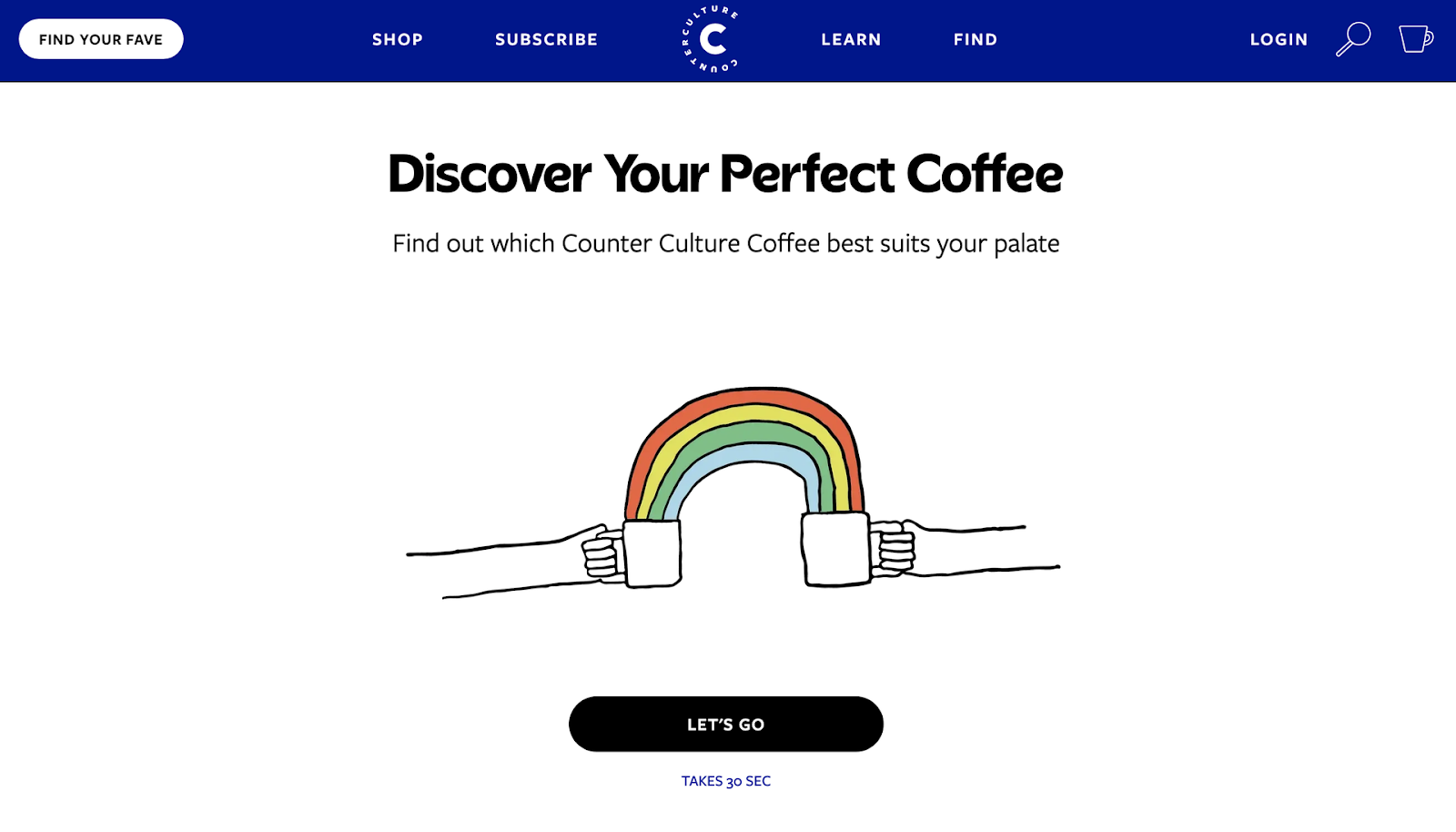
The quiz encourages—but doesn't require—visitors to share their email addresses. Using this zero-party data, the coffee company can build customer profiles for personalized marketing.
Next Steps to Leverage B2C and B2B Ecommerce Trends
Knowing how to start an ecommerce business is just the first step. To meet business goals and stay ahead of the competition, you should monitor emerging ecommerce trends and implement those most relevant to your business at the right time.
Among other things, Semrush can help you streamline your content and social media marketing efforts, improve your ecommerce SEO, and optimize your ad campaigns. Sign up for a free Semrush trial to get started with tools like PLA Research and Ecommerce Booster.
